C.M.B.
Albertville Class - MS Charlesville, later renamed the Georg Büchner
Please Note: Firefox, iPhones, iPads &
some other Search Engines may not be suitable
Use Internet Explorer & Google for
this Web Page to load perfectly!

Click the
logo above to reach the ssMaritime FrontPage for News Updates
With
Reuben Goossens
Maritime
Historian, Cruise‘n’Ship Reviewer, Author &
Lecturer
Please Note: All ssmaritime and my
other related ssmaritime sites are 100% non-commercial and
privately owned sites. Be assured that I am NOT associated with
any cruise or shipping companies or travel/cruise agencies or any
other organisations! The author has been in the passenger
shipping industry since May 1960 and is now semi-retired, but
continues to write article on classic liners and cruise ships in
order to better to inform cruise and ship enthusiasts for their
pleasure!
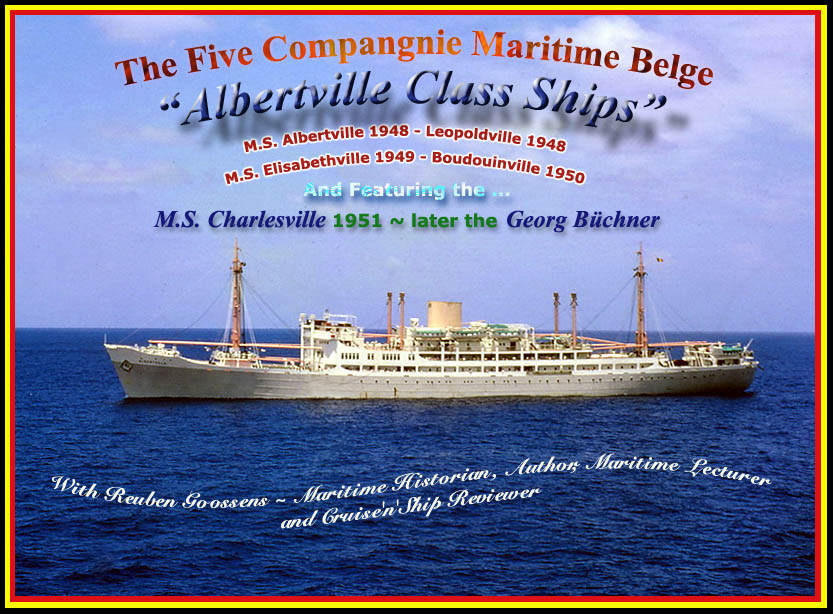

Page
One: M.S. Charlesville
Introduction:
As
the above image states, the MS Charlesville was the last of five
sister ships built, being the “CMB Albertville Class”
ships, obviously named after the vey first of five delightful
10,901 GRT delightful Passenger-Cargo Liners, the M.S.
Albertville built in 1948, with the last of the series was
completed in 1951. All of these beautifully built Belgium liners
were especially built for the Belgium / Congo service. All five
ships were built by J. Cockerill S.A. Hoboken.
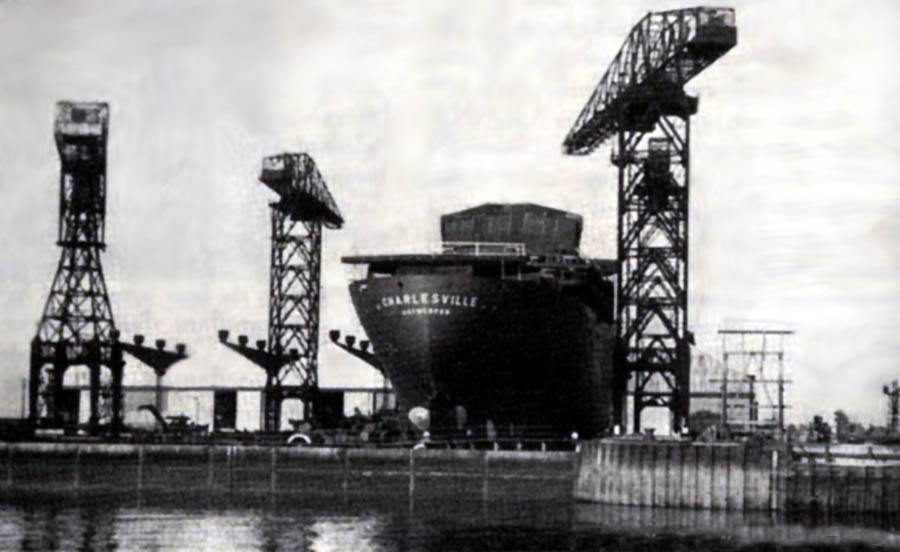
The Charlesville
seen in building
Photograph
GVM / © copyright Flor Van Otterdyk -Belgium
The MS Charlesville was built by the famed John
Cockerill Ship Builders, in Yard 743 in Hoboken, Belgium and she
was the last of the “CMB Albertville Class series of
ships,” being the; M.S. Albertville, Elisabethville,
Leopoldville, Baudouinville, later renamed Thysville, and finally
the M.S. Charlesville.
A Short Background on
“Cie Maritime Belge:
“Cie Maritime Belge” was founded in
1895 under the name “Compagnie Belge Maritime du Congo”
(CBMC). At the request of King Leopold II of Belgium and with
support from British investors, a maritime connection was opened
with the “Congo Free State.” Their very first ship the
Leopoldville departed on her maiden voyage on February 6, 1895
and she was the company’s first ship to leave the port of Antwerp
bound for the Congo. Interestingly, it had been for some sixty
years that the Dutch “Kongoboten” Congo boats, had been
present in the Port of Antwerp, as the Dutch ruled the oceans
over the years, even more so than the British, thus the reason,
the British invested into the Belgium Company!
In 1930 CBMC purchased another Belgium company
“Lloyd Royal Belge,” and the company name was shortened
to “Cie Maritime Belge” (CMB), mostly due to new
services having been obtained towards America as well as the Far
East. But amazingly the company had become closely associated
with some thirty two “Ville” ships operating between Antwerp
and the Belgian Congo, which was quite an achievement!
Building a New Fleet:
CMB that provided passenger and cargo services
between Antwerp and the Belgian Congo, however they sadly
suffered huge losses during the Second World War. The company was
somehow able to rebuild a new fleet of ships and offer regular
services between Antwerp and the Belgium Congo, and do so with a
with new fleet of ships operating on a fortnightly basis.
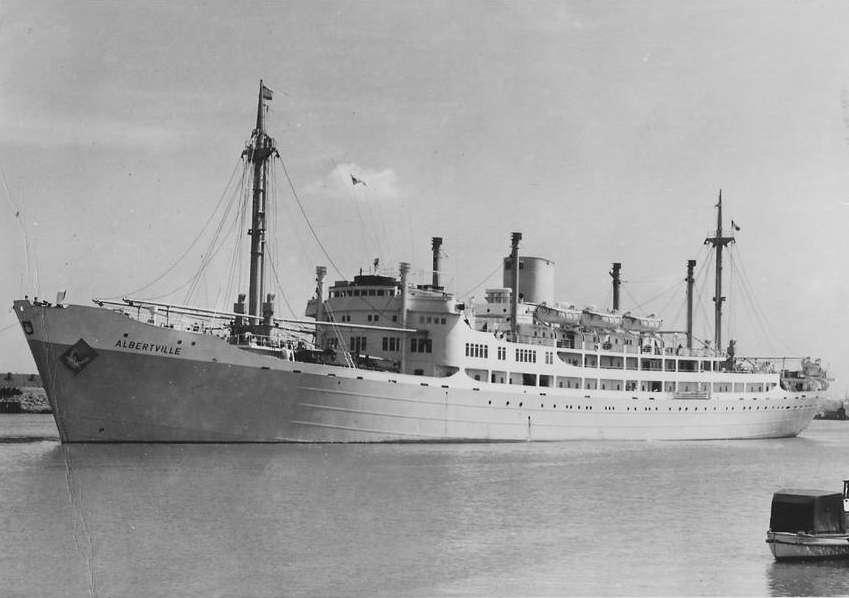
Here
we see the first of the series, the M.S. Albertville of 1948
The first ship taken into service was the Albertville
(10,901 GRT), next came the Leopoldville (10,901 GRT) followed by
the Elisabethville (10,901 GRT). The last two ships of this class
the Baudouinville (10,946 GRT) and the Charlesville (10,946 GRT),
although being identical in dimensions, but had additional
passengers accommodations. This was mostly due to the relocation
of the Dinning Room down to D Deck, (top deck in her hull), which
together with the galley, occupied the greater part of hold 2 and
the area aft of it. Whilst the first three ships had their
Dinning Room located far forward of the superstructure on Shelter
(C) Deck.
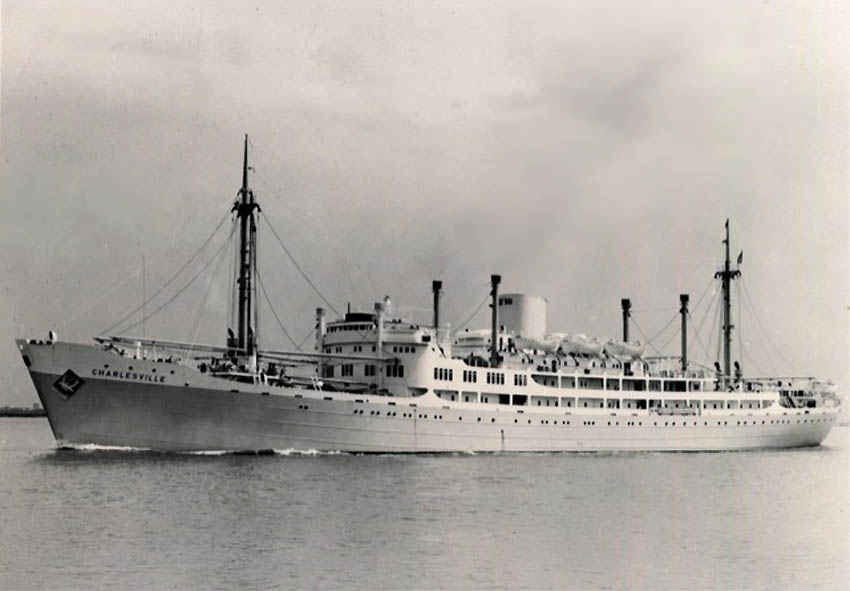
M.S. Charlesville
– Note the Dinning Room portholes forward where hold 2 is
supposed to be
And
compare this to the photograph above of the M.S Albertville!
View
the … Albertville-Deck-Plan the deck plan was sourced
with thanks
from
the - “Belgian Ships Archive” - www.belgischekoopvaardij.net
However, with four ships built and in operation
to the Belgium Congo, finally on March 6, 1951 the MS Charlesville
commenced on her maiden voyage to the Congo and operated a
successful service. After the Independence of the Congo in 1960,
when it became the “Democratic Republic of the Congo”
the service continued as usual!
Ports of Call: Antwerp, Tenerife, Lobito
in Angola, Matadi the Congo. On her return voyage a call would
also be made at the port of Boma in the Congo.
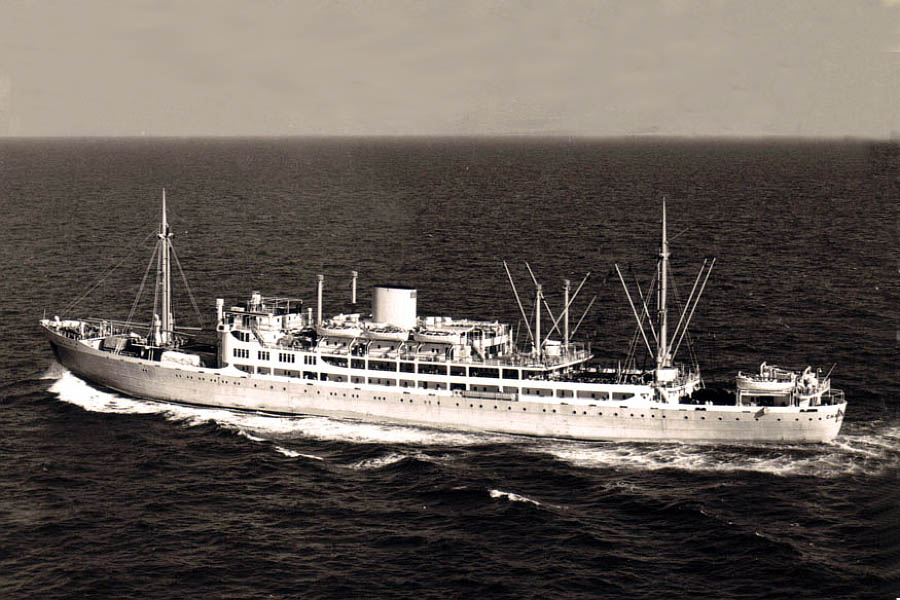
M.S. Charlesville
seen at full speed ahead, bound for the Belgium Congo

Starboard
side view of the ship
Part
of the above mentioned deck plan sourced with thanks from …
“Belgian Ships Archive”
The Charlesville’s
Deck layout:
Decks on all of the five Albertville ships were
arranged as follows, all having Five Passenger Decks: Pool
Deck, Bridge (Navigation) Deck, A (Boat) Deck, B
(Promenade) Deck, C (Shelter) Deck, and D
Deck.
The Charlesville, being the last of the series,
there was no doubt that she would be the finest if the series,
having the finest fittings as well as the latest in technology! A
(Boat) Deck offered her passengers spacious decks for strolling,
sunning or for sports as there were facilities available on both
sides as well as aft, whilst the interiors were mostly reserved
for officer accommodations, including their mess, lounge, etc.
However, far aft there was the Children’s Playroom that was
spread right across the superstructure and it had every possible
facility and was fully supervised! This venue could be reached by
an exclusive internal stairway on the portside from B Deck.
Considering that the Bridge and forward section of this deck that
contained accommodations for the Captain and his first officer,
that section was separated by hold 3.
However, above A Deck just aft of the ships
funnel was the location for the outdoor Swimming Pool on Pool
Deck, which was surrounded, forward and the sides by steel
and windows as well as steel roofing that surrounding the pool
area, but the pool itself remained open to the air.
Her Interiors and
Cabins:
Her overall décor was delightful featuring a
touch of fine timbers combined with excellent art and other
interesting articles on Promenade deck as well in her Dinning
Room! Her accommodations were spread over her three main decks,
B, C and D Decks.
Far forward on Promenade (B) Deck was a
spacious Lounge or, the Salon, which had a delightful décor,
along her aft centre wall there was a feature timber wall piece,
with a matching, but wider cabinet below. Vertical panels
finished this wall along the sides! The Salon was surrounded by
windows, was followed making it a light and bright room during
the day, and it offered a variety of furnishings, and rich
carpeting. It had from upright tables and chairs, to armchairs
and sofa with coffee tables, ass well upholstered. It was the
perfect Lounge! On the port side there was an entrance to a small
lounge called “The Living (rest) Room.” It was similar
to the old days when there was a “Ladies Lounge” for
the women to go and rest in, but this venue was more of a quiet
room for all!
Directly aft of the Salon was the delightful
Smoke Room with a bar, which was a more casual venue with the
floor clad in a coloured rubberised non slip material. Again
timber was the highlight here and the venue was warm and
obviously very popular!
Amidships there were a good number of cabins,
including several more spacious ones located forward that could
be sold as separate rooms, or even as two roomed suites,
accommodating up to four persons and a child, having two
bathrooms. In addition there were twin bedded cabins, as well as
single cabins that could also be sold as two berth cabins! All
accommodations on this deck had private facilities.
But the M.S. Charlesville had one delightful
feature located far aft on Promenade (B) deck, and that was the
delightful Café a very special venue considering it was
beautifully timbered and on the aft wall there was a delightful Congo
based piece of art, which was a talking point on any voyage
considering it was so beautiful! The venue was in a U shape, with
it arms heading forward. On the starboard side aft, was the bar
that serviced the venue, whilst the entrance to the Café from
interior the ship was located on the portside.
As far as deck space is concerned as the Cie
Maritime Belge brochure said it well, that there was; “Ample
space for deck games and promenading.”
On Shelter (C) Deck most of the ships cabins
and the majority had private facilities, whilst those on D Deck
(top hull deck) did not have private facilities, but there were
ample spotless share facilities available.
Located far forward on D Deck, using the space
where in the first three “Albertville ships” would be
the aft section of number 2 hold, here onboard the Charlesville
was the spacious and beautiful Dinning Room that was able to seat
all passengers in a single sitting. On her forward middle wall
there were two large fine pieces of art, whilst on the aft,
entrance side it featured a large mirror and some wall décor, as
well as the two main entrances! This venue had long tables many
set across the room, but some smaller ones length ways. The
chairs were of fine timber with luxuriant chequered upholstery,
and although a large room, a most pleasant one!
The accommodations ranged from single bed
cabins, but the majority on Promenade Deck were twin bedded, on
Main Deck, the same applied, but many twins could be sold as
three or four berth cabins on Main, and on Tween decks. This
would not apply to certain deluxe rooms on Promenade Deck, for
these were exclusively for one passenger or two. Thus there is no
doubt that her 217 passengers were superbly accommodated, as
would be the 31 children who were berthed in their special
children’s berths!
Photo
Album
1: Pool Deck
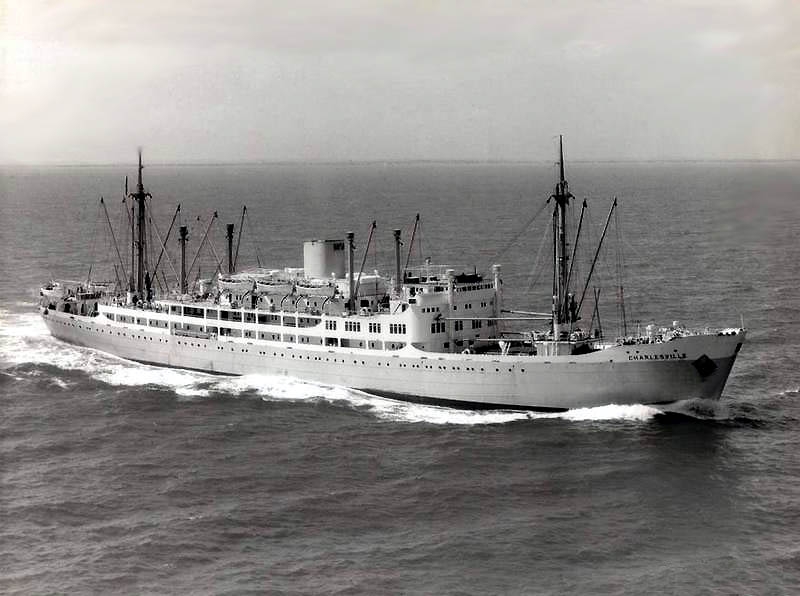
A
fine view of a perfectly designed liner!
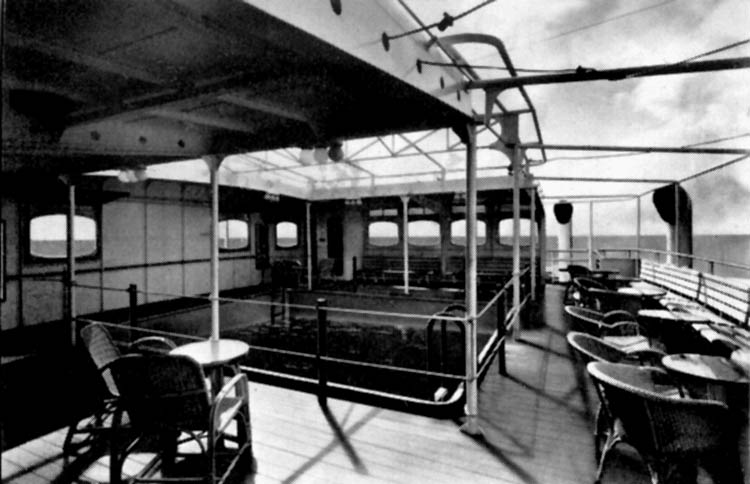
The
Ships Swimming Pool, atop of the ship, just aft of the funnel
2: Promenade (B)
Deck
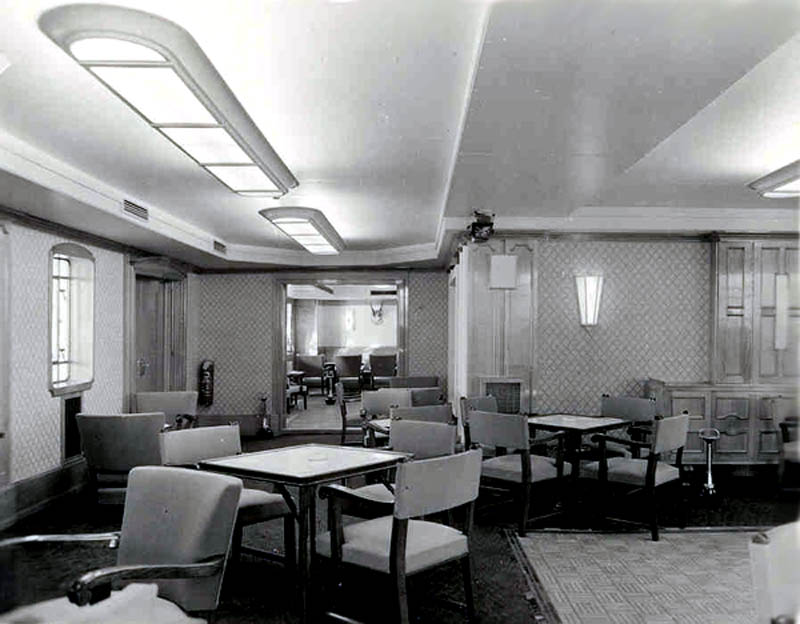
A
most comfortable and delightful Main Lounge, also known as
“The Salon”
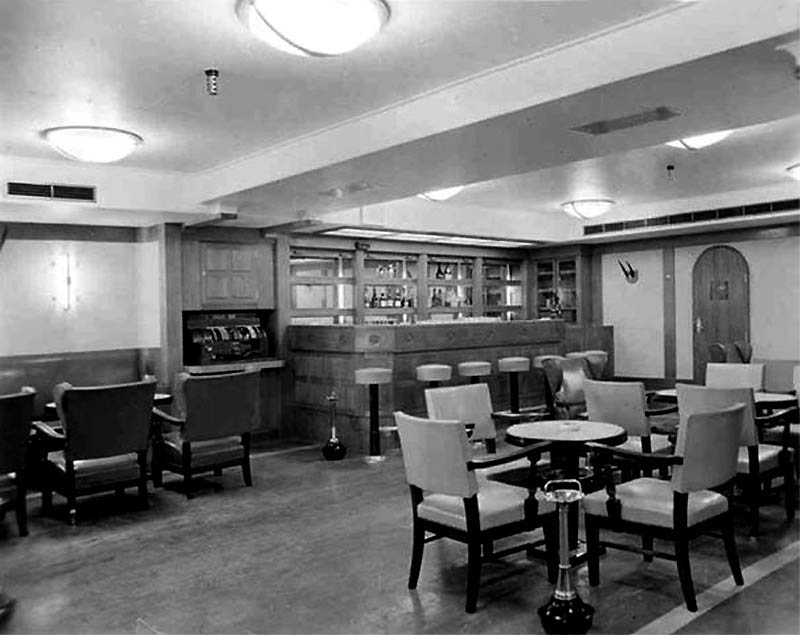
In
the old days the Smoking Room with a cosy Bar was very much a
tradition, and it was located just aft of The Salon
Can
you imagine, if they place a Smoking Room back onboard cruise
ships today, there would be an outrage!
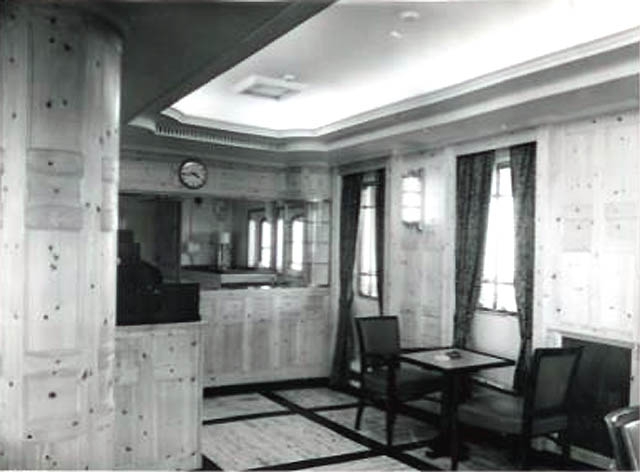
Starboard
is the Bar of the spacious Café, perfect for a drink
or
two, or even some morning or afternoon Coffee or Tea!
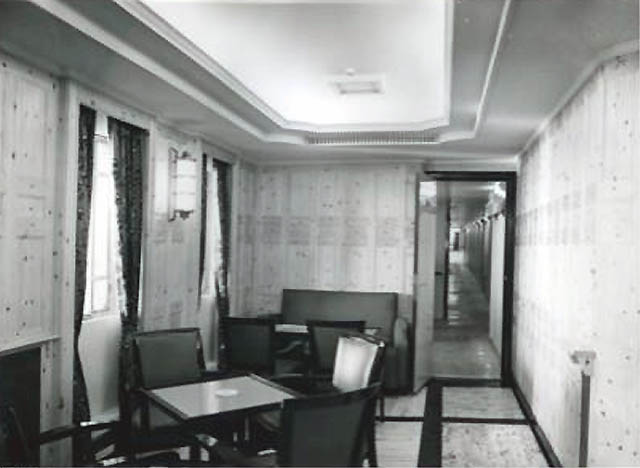
On
the portside is the only interior entrance to the Café’
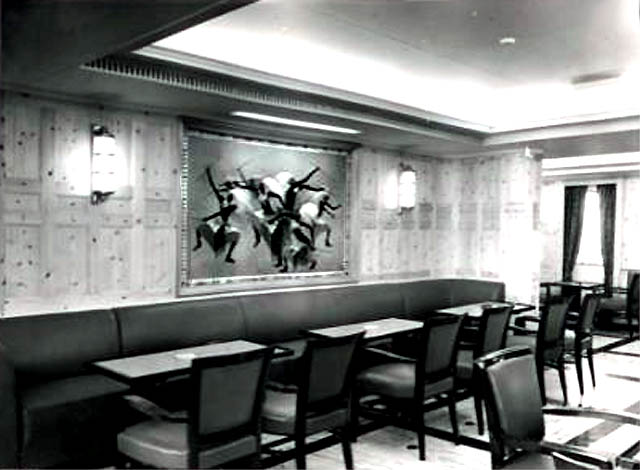
Here
we see the main section of the Café and its famed artwork being
its centre piece
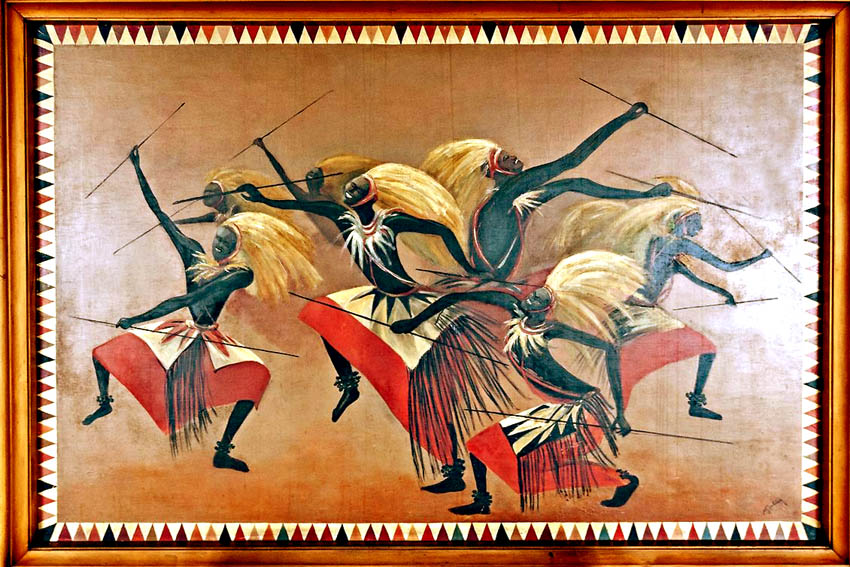
A
superb photograph of the popular of art in question!
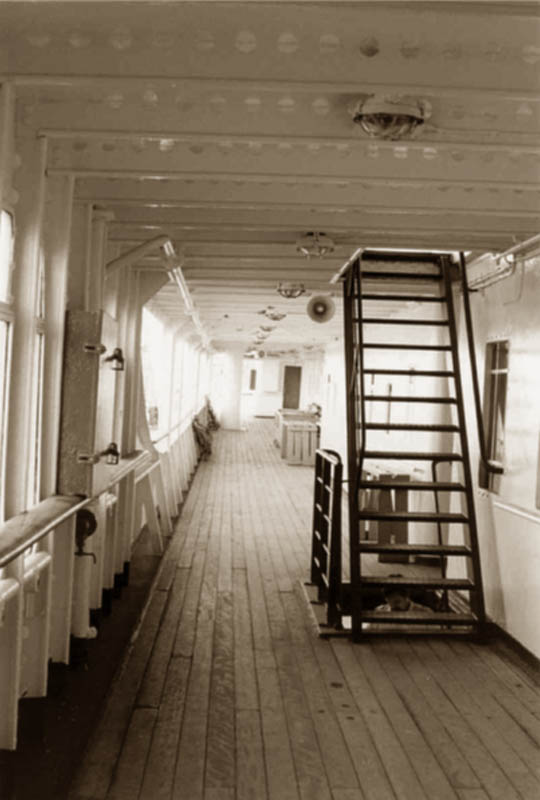
Promenade
Deck
3: Shelter (C)
Deck
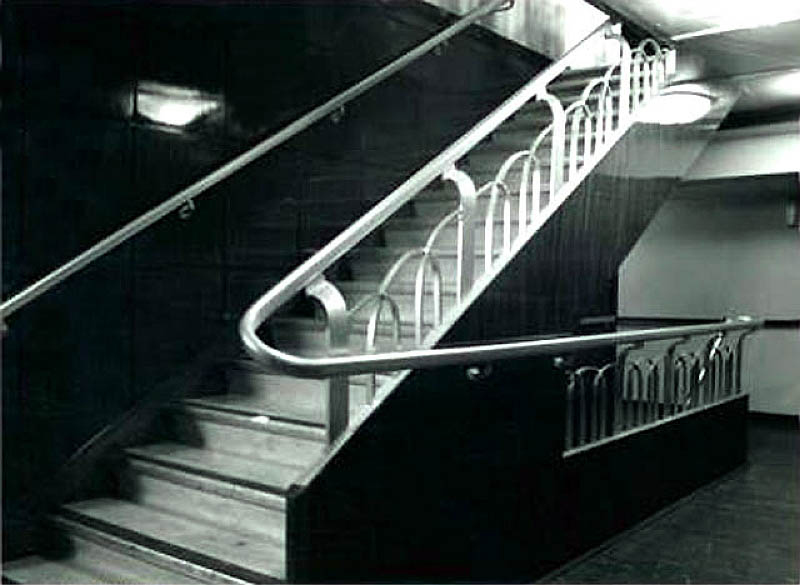
Here
we see the stairwell is seen on C Deck
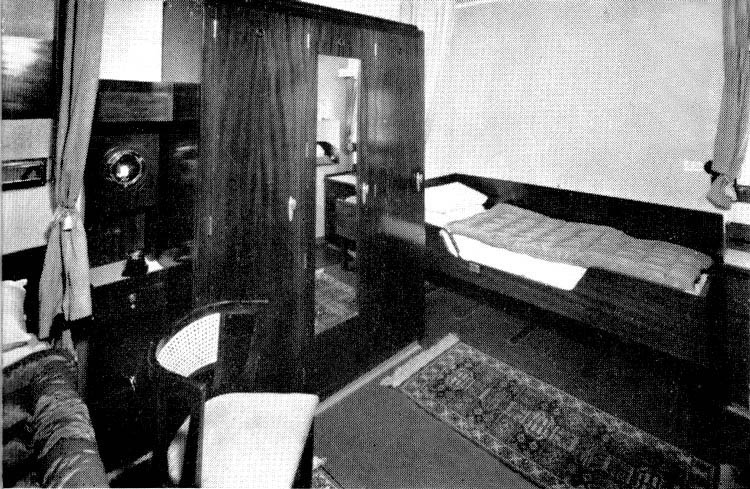
A
Twin bedded cabin with Private facilities on C Deck
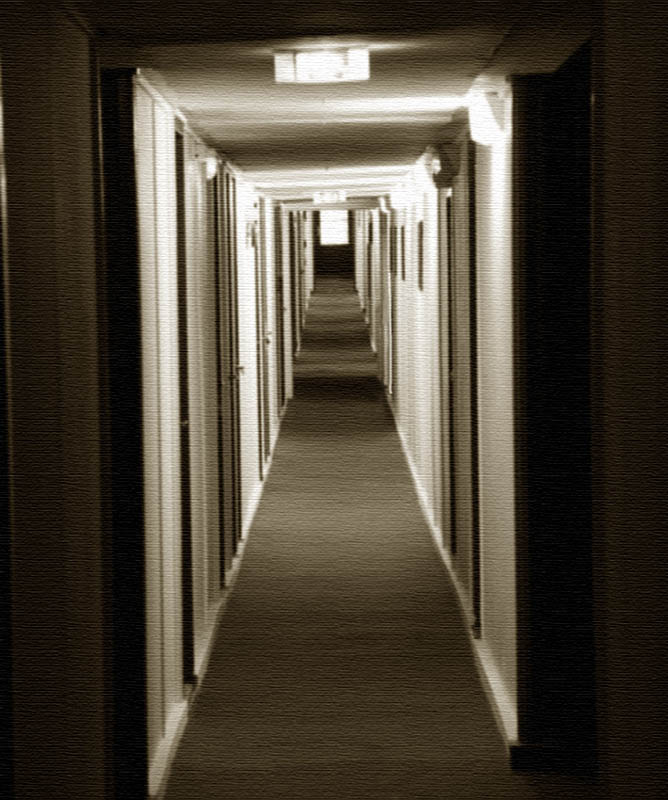
Hallway
on C Deck from to aft deck
4: D Deck
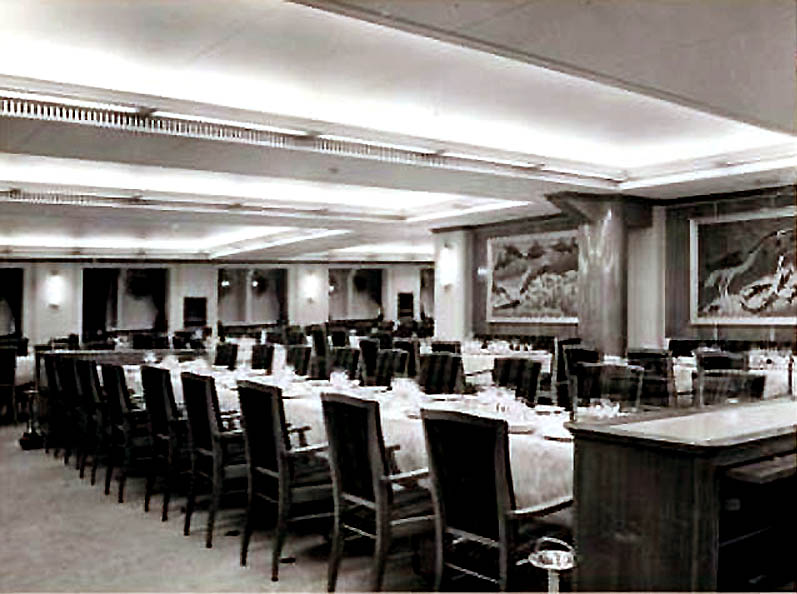
Above
& below: The Main Restaurant far forward on D Deck
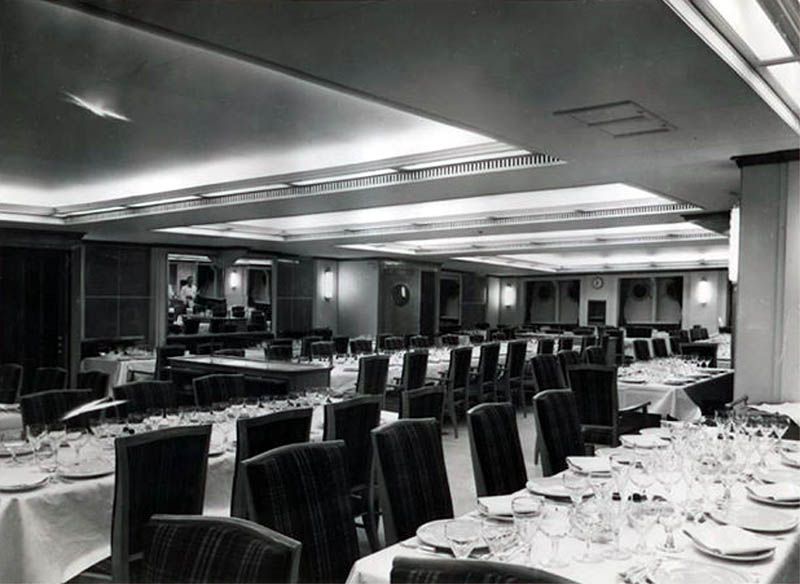
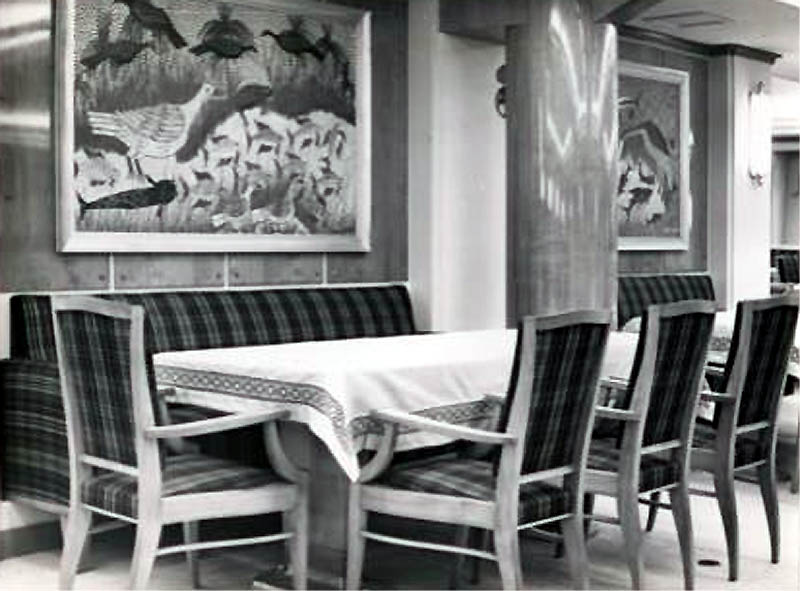
This
is a fine image of some pieces of art on the forward wall in the
Dinning Room
As we
have seen on the photo in the middle, which is the entrance,
there is a large mirror on the wall!
Other facilities available onboard were the
ships shop, barber/hairdresser, medical facility and the pursers
office.
The M.S. Charlesville and her sisters continued
a long and proud Belgium shipping tradition of beautifully built
ships that were not just well built but offered wonderful public
facilities, excellent accommodations, fine food and superb
service!
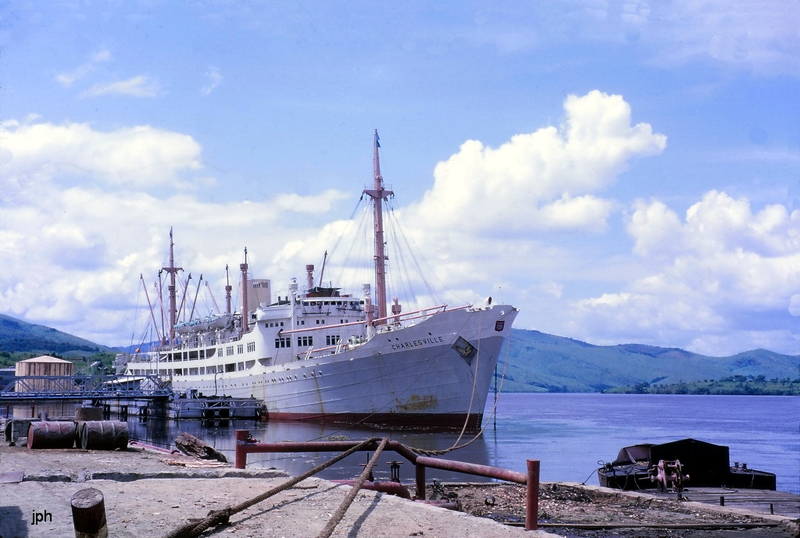
The Charlesville
seen in the Belgium Congo at Ango Ango
Photograph
by & © Jean-Pierre Hack, Belgium
Please Note: Although on this feature I
will not be covering the first four ships, only provide the
information as I have previously given above, however, I have
already written on the fourth of the sisters the M.S. Baudouinville
(2), which was later renamed the MS. Thysville and she then
sailed under a number of companies and names, such as: RMS Anselm,
M.S. Iberia Star, finally to become the “Austasia
Lines” MV Australasia from 1965 to 1972.
To read all about this ship, you will find link
provided towards the bottom of this page.
Engine refit in 1957:
On July 23, 1956 the first of two brand new
liners, the 13,724 GRT M.S. Jadotville which was able to
accommodate some 300 passengers, commenced her maiden voyage from
Antwerp to the Congo.
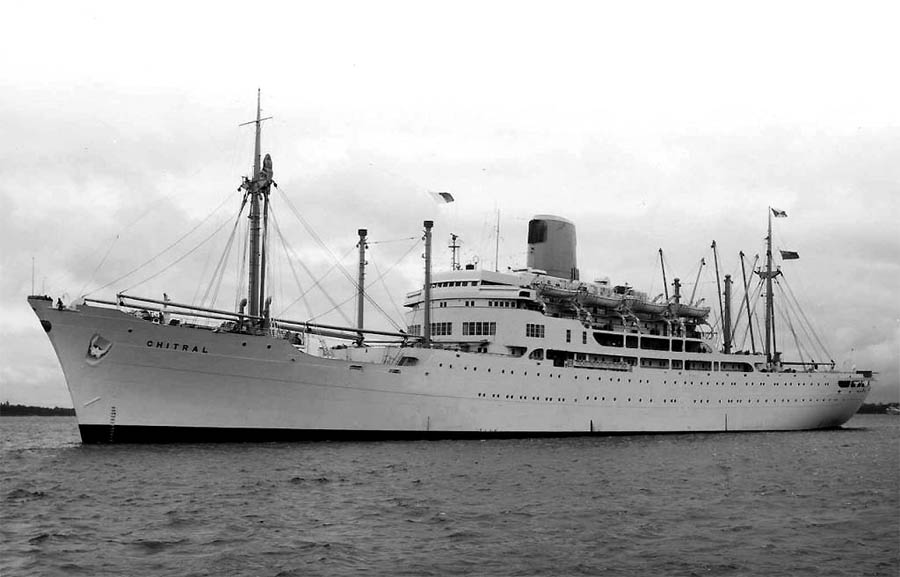
Here
we see the M.S. Jadotville in her new guise as the Chitral, as
she was sold in 1961 to P&O
Both
these sisters were sold to P&O in 1961
She and later her sister had a better speed of
16.5 knots, thus it was decided to upgrade the five “Albertville
ships”!
Thus on May 18, 1957 the conversion of the Charlesville
propulsion plant commenced with an additional piston mounted
above the cylinder, which would compress the air in the cylinder,
with the end result being of 9,250 BHP, offering a service speed
of 16.5 knots to a maximum of 17.4 knots, being a great
improvement over her previous 7,200 BHP and a speed of 15 to a
maximum of 15.5 knots. This improvement shortened her
round-voyage Antwerp - Matadi - Antwerp was shortened by two
days.
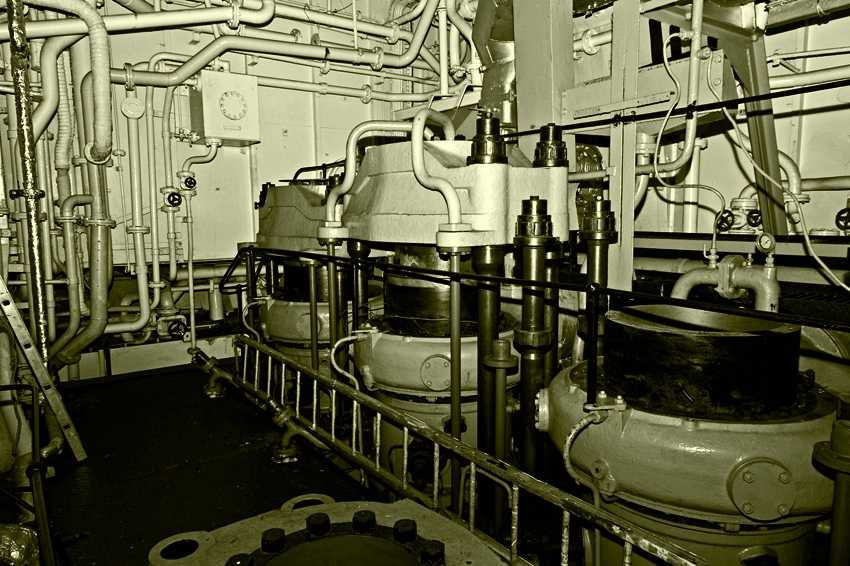
The Charlesville
engine room
M.S.
Charlesville - Specifications:
IMO
number:
5068863.
Built
at:
J. Cockerill S.A. Hoboken, Belgium.
Yard:
743.
Launched:
August 12, 1950.
Maiden
Voyage:
March 6, 1951.
Tonnage:
10,946 GRT - Gross Registered Tons.
Length:
153.66m - 505ft.
Width:
19.60m - 64.3ft.
Draught:
8.39m – 27.6ft.
Engines:
1 x Burmeister & Wain Cockerill double-acting
.
eight-cylinder two-stroke diesel engine.
Propellers:
One - 9,250 BHP.
Speed:
16.5 knots service speed.
Passengers
Decks: 4.
Passengers:
217 passengers and 31 children beds.
Crew:
140.
Images
of the Delightful M.S. Charlesville
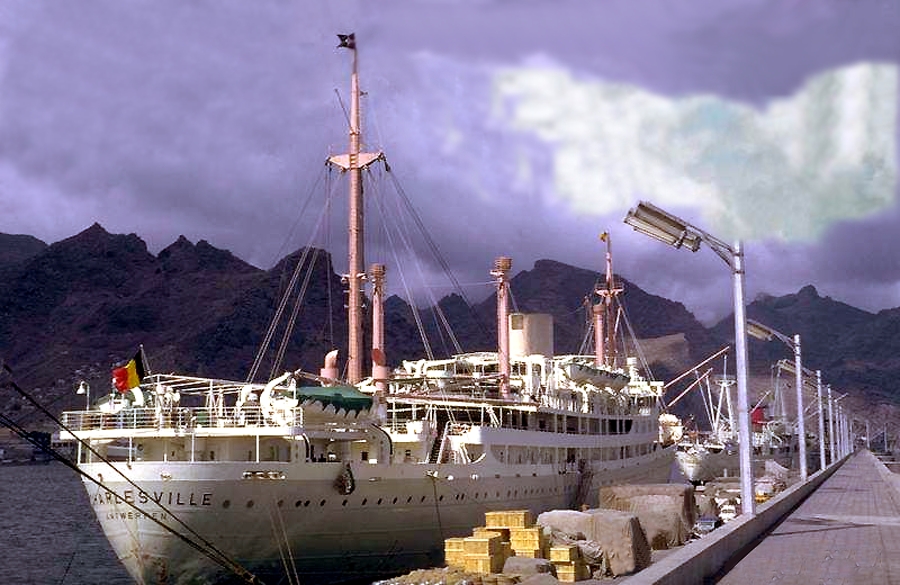
An
excellent stern view of a working ship the M.S. Charlesville
berthed in Tenerife the Canary Islands
Photograph
by & © Jean-Pierre Hack, Belgium
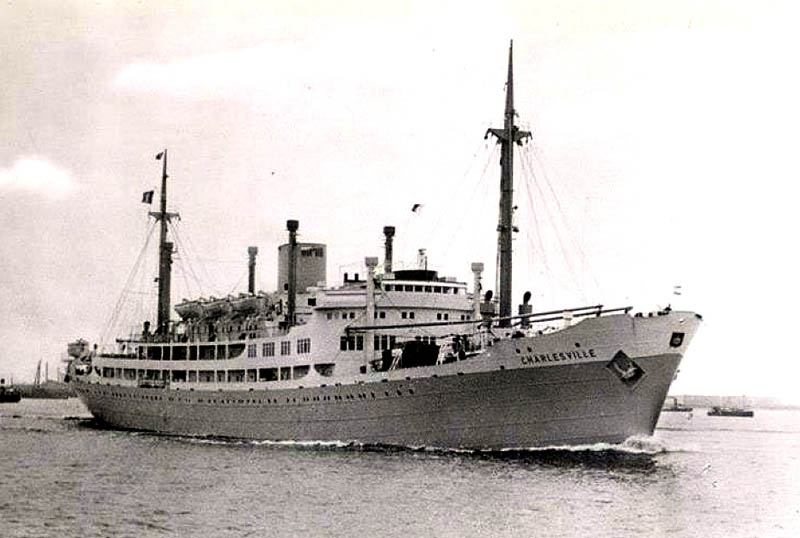
She
heads off once more on one of her many voyages
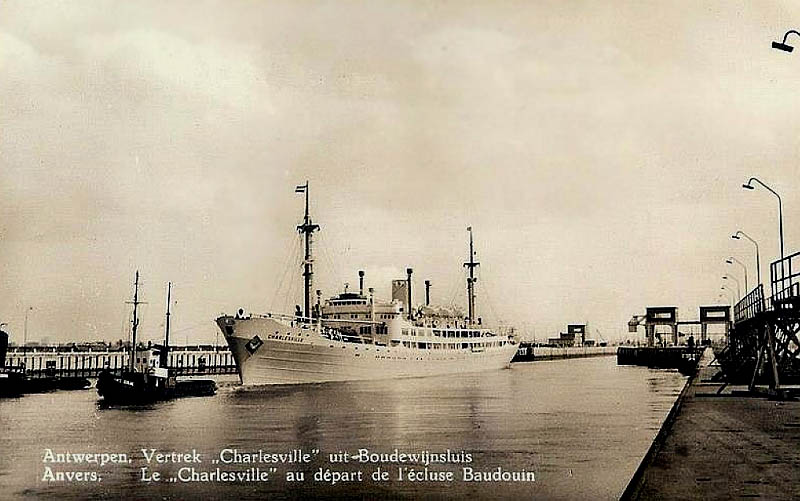
A
delightful older Belgium postcard in Dutch & French of her
departing Antwerp
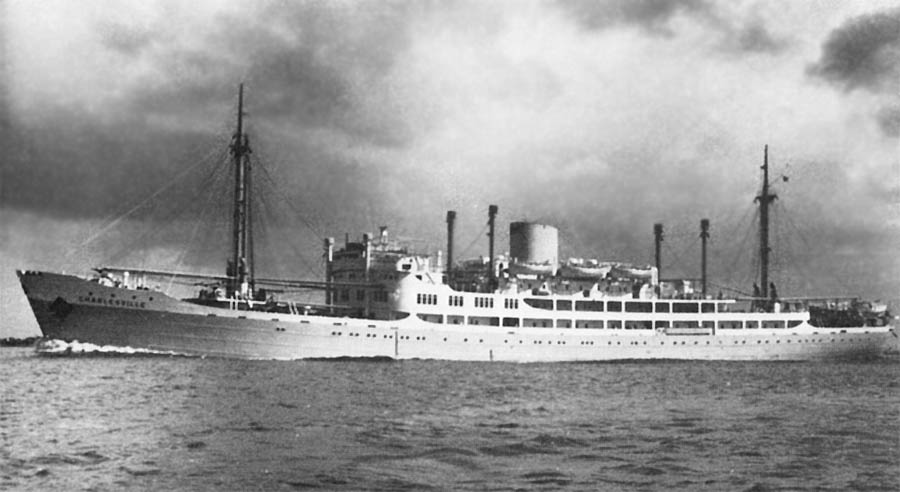
Here
we see her when she was obviously heavily loaded as she is well
down, and heading for Matadi
Photo
sent in by a supporter, but photographer is unknown – Please
see my “Photo notes” at bottom of page
Just for interest the second of the new liners,
the M.S. Baudouinville commenced her maiden voyage on November 2,
1957 and joined her sister the Chitral. But sadly their lives
were rather short as both ships were sold to P&O in 1961 to
be renamed the M.S. Chitral and Cathay and were placed in Australia
to operate the Australian Asian service.
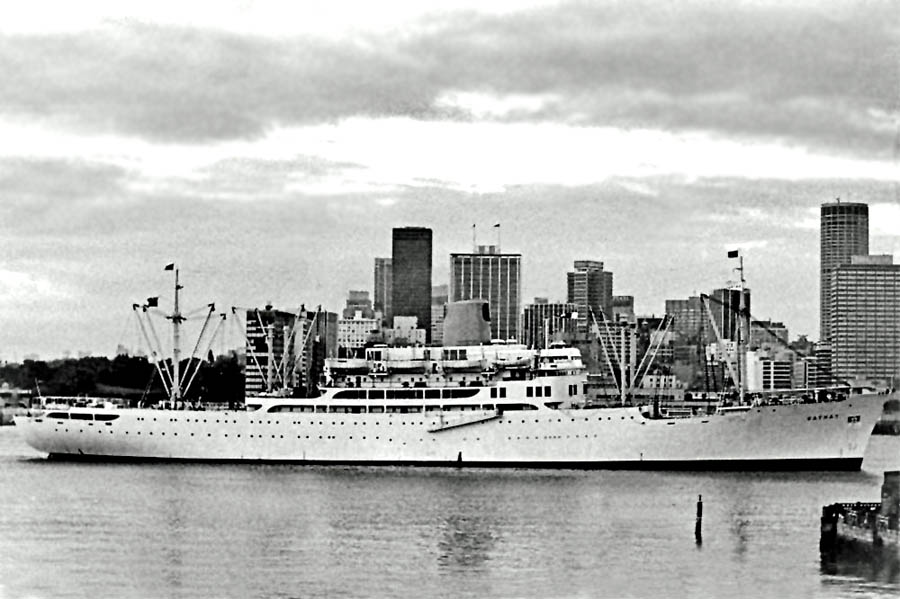
Here
we see the second and the very last of the company’s
passenger liners built the M.S. Boudouinville
in
her new guise as the M.S. Cathay, as she was sold in 1961 to
P&O
Rescue at Sea:
Having been completed, she returned to her
regular duties and sailed on for the next ten years, although she
did have one particular encounter that would place her into the
Maritime History Books forever!
The famed Dutch liner, the M.S. Johan van Oldenbarnevelt
was sold on March 8, 1963 to the Greek Line and she received a
minor refit to become their new cruise ship, the T.S.M.S. Lakonia
that departed on April 24 for their very first cruise departing Southampton.
She proved to be a huge success for the Greek Line, and they
decided to do some further work on her, thus from December 9 to
December 13, 1963, she underwent another minor upgrade. A new
pneumatic fuel injection system was installed. Cabins were
redecorated, and the kitchen and pantry were completely
remodelled.
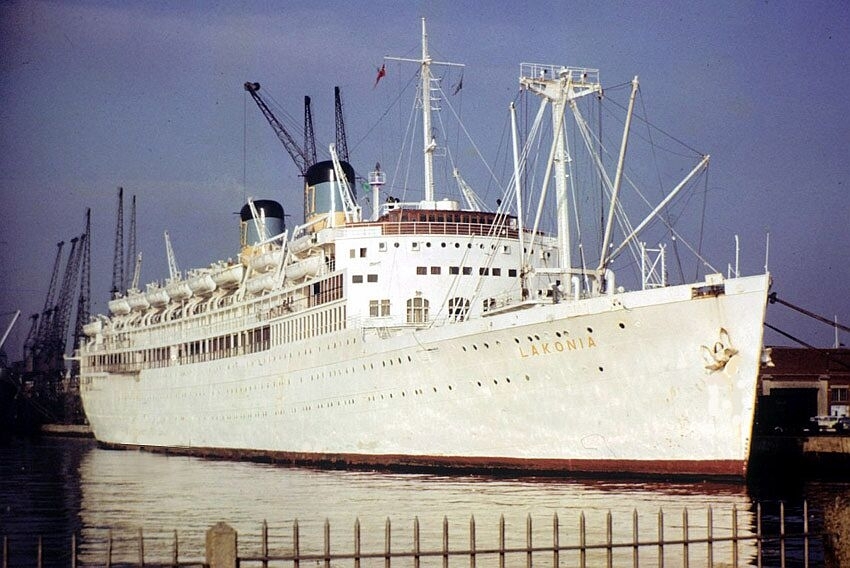
T.S.M.S
Lakonia is seen here in Southampton on April 24, 1963
©
ssMaritime.com
In addition, the Lakonia was outfitted with a
number of safety features and she carried 24 lifeboats capable of
holding 1,455 people. The ship had an automatic fire alarm system
and two fire stations with specialised fire fighting equipment.
There were lifejackets for every person on board and an
additional 400 lifejackets stowed on deck.
She departed Southampton on December 19, 1963
for an 11-day “Christmas Cruise” of the Canary Islands,
with her first port of call being the island of Madeira. Aboard
there were 646 passengers and 376 crew and officers, thus a total
of 1,022 people.
However, on Sunday, December 22, 1963
around 10pm smoke could be smelled in the lounges and fire had
broken out on this great ship. Obviously, in due course an S.O.S.
was sent out, and an abandon ship call was made. I will not go
into the good or the bad of the events on board, etc, but there
was great bravery by certain people and they have been well
recorded!
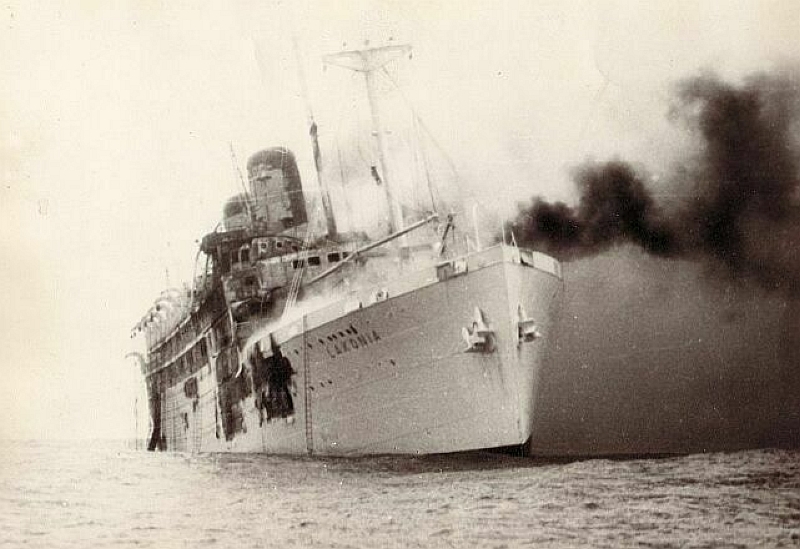
The Lakonia
seen still smouldering the next day
Photograph
by Gerhard Jourdan a sailor on the M.S. Charlesville
Who
himself was involved in the rescue operation
Photograph
provided by Gerhard Jourdan
The ships that came to her aid were the
Argentinean Passenger ship Salta, under Captain José Barrere,
followed by a British tanker the Montcalm. The thirds ship on the
scene achieved so much, and that was the Charlesville, which
worked so hard in saving so many lives from this horrid disaster,
including taking the last man from the burning ship, being the
captain. Sadly, due to this tragedy there was a loss of 98
passengers and 30 crew members: thus, 128 precious lives had
perished! As sad day indeed!
The M.S. Charlesville was one of the latter
ships to arrive on the scene, due to the distance she had been
from the tragic scene in December 1963 on the day after the fire
commenced she played her own role in the rescue of survivors from
the burning Greek cruise liner the Lakonia. She took on board a
number of bodies, but thankfully was o save thirty four people,
with six of these being passengers, and twenty eight being crew
members, including Lakonia’s captain Zabris. All the
survivors were taken to Tenerife; however those who were dead,
where buried at sea.
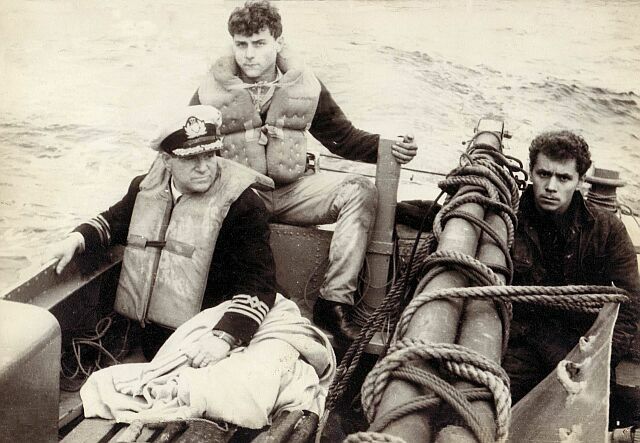
Charlesville’s
Engineer Jean-Marie Kolbach seen at the tiller of the lifeboat
that has
just
rescued Lakonia’s Captain Zabris who is sitting just in
front of him
Photograph
provided by Gerhard Jourdan
For the complete story of the events of those
horrid days, and the brave work done by the crew of the M.S. Charlesville,
read the author’s online book “Memories of the JVO”
and you will find that page 8 contains all the details with many
more photographs! There is a link further down the page, which
will take you directly to that page!
Other Events:
In addition, there were a number of other
events, although there are little to no details available
regarding these, as they are but simple “Log entries”
with no further information being available.
Mar
26, 1960:
Log entry: Collision with MS Hirondelle.
Jun
13, 1962:
Log entry: Damage after collision with the MS Adoracion in Tenerife.
Jul
08, 1962:
Log entry: Damage after collision by MS Kano Palm in the port
of Matadi.
Apr
16, 1963:
Log entry: Grounded in the Convenseight-pass on the river Congo.
Oct
18, 1963:
Log entry: Assistance to the MS Manticos near Bijouga (Guinee-Bissau).
Her Final Days:
However, after the eventful events of the
tragic time with the Lakonia, sadly the M.S. Charlesville only
had another three and a half years left with “Cie Maritime Belge”
for it had become obvious that passenger and cargo traffic was
lessening worldwide, being due to both the popularity of air
travel and the arrival of the Jet age, as well as the
modernisation with the introduction of container ships, which
were slowly taking over the majority of the cargo trade.
Thus sadly the companies management had to come
to the decision sell this fine traditional passenger-cargo Congo
liner.
Back in 1961, Cie Maritime Belge had already
sold their two newest built passenger liners, as well as the M.S.
Baudouinville, which they had renamed the Thysville as the new
ship was given her original name, but now in the 60s it was time
for another two of the famed Belgium “Albertville
series” to go, the first to be sold was the M.S.
Leopoldville, followed by the M.S. Charlesville!
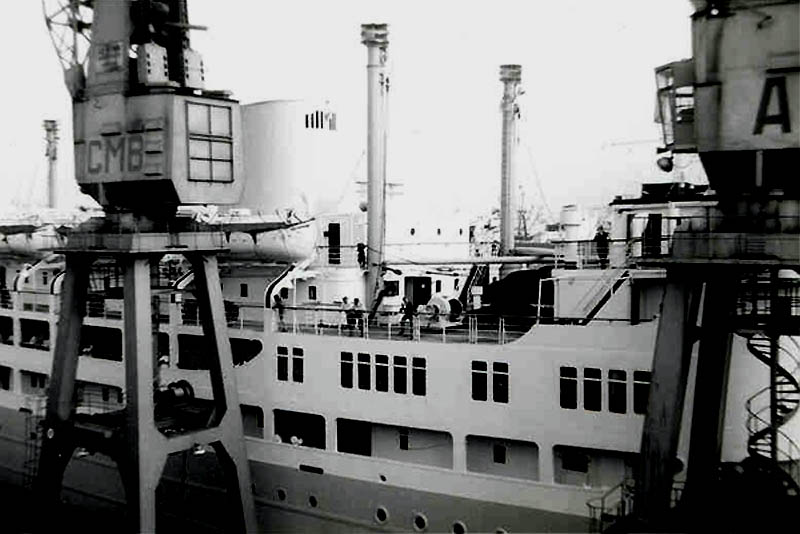
But
as we see the Charlesville departing in 1966 and she was still in
full operation, but sadly not for much longer
Photographer
unknown – Please see my “Photo notes” at bottom of
page
This meant that only the very first ship of the
series, the M.S. Albertville remained in service, and she did
continue until she was finally sold to the breakers and departed Antwerp
late February 1973 bound for Taiwan, where she arrived on April
19, at the breakers yards at Kaohsiung where she was duly broken
up.
A new life of the Charlesville:
On July 5, 1967 that the M.S. Charlesville was
sold to the East German shipping company, “VEB Deutsche Seerederei”
of Rostock who renamed her Georg Büchner, after a famous German
writer from the 1800s.
The Georg Büchner Story will be continued on
Page Two:
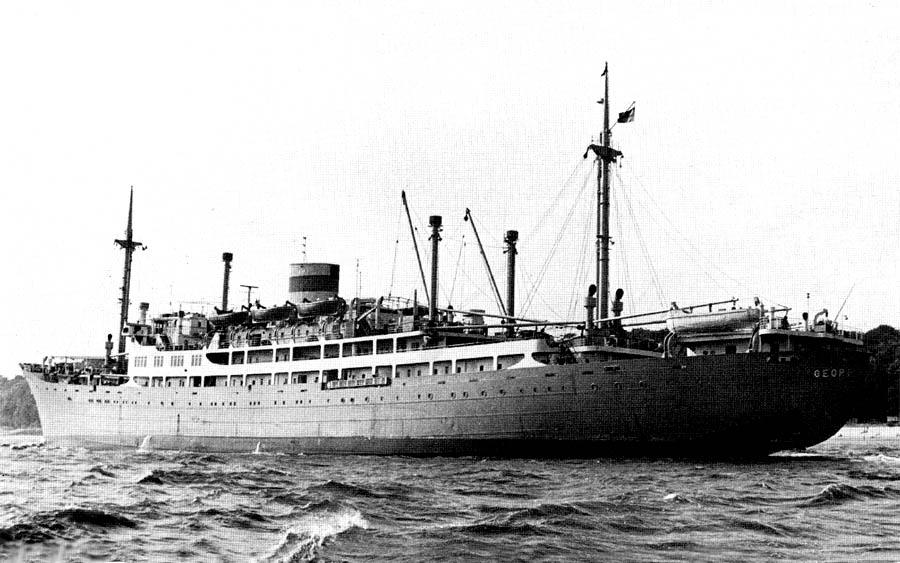
The
M.S. Georg Büchner seen at sea
Photographer
unknown – Please see my “Photo notes” at bottom of
page
Special Links:
Link One:
Read about one of her sisters the M.S. Baudouinville
(2), which was renamed the M.S. Thysville and
eventually became the delightful Australian based liner, come
cruise ship, the MV
Australasia.
Link Two:
Visit: Lakonia's
Final Voyage - This is just one page out of an
extensive feature entitled “Memories of the JVO.”
This was a greatly loved liner for so many years, especially when
she operated between Europe and New Zealand and Australia, as
well as the United States!
Link Three:
Please watch this wonderful video on the M.S.
Charlesville / Georg Büchner at: http://vimeo.com/65285403.
It was made by the Belgium’s as part of a campaign to save
her, but sadly it has now failed, as we will discover on Page
Two! The video shows in part, the ship in her original state and
it will provide some wonderful insights to her happy days as a
fine liner filled with happy passengers!
Link Four:
The ship now needs your help as we are
working on saving her, and believe me IT IS A BIG JOB!
Enter the; Save The
Classic Liners Campaign.
Photographs
on this feature are from: 1, the author’s personal
travel agencies collection. 2, as sent in by supporters, and 3,
as stated!
M.S.
Charlesville Index:
Page One:
M.S. Charlesville from construction, maiden voyage in 1951 to her
sale in 1967. (This Page).
Page Two:
M.S. Georg Büchner from 1967 read her history through to her
tragic end in 2013.
“I
will always love her because she was a Belgium Congo Liner, the M.S.
Charlesville
for
it was that what made her so special to me!”
Who
said that? Actually it was me, the author! Reuben
Goossens - Australia.
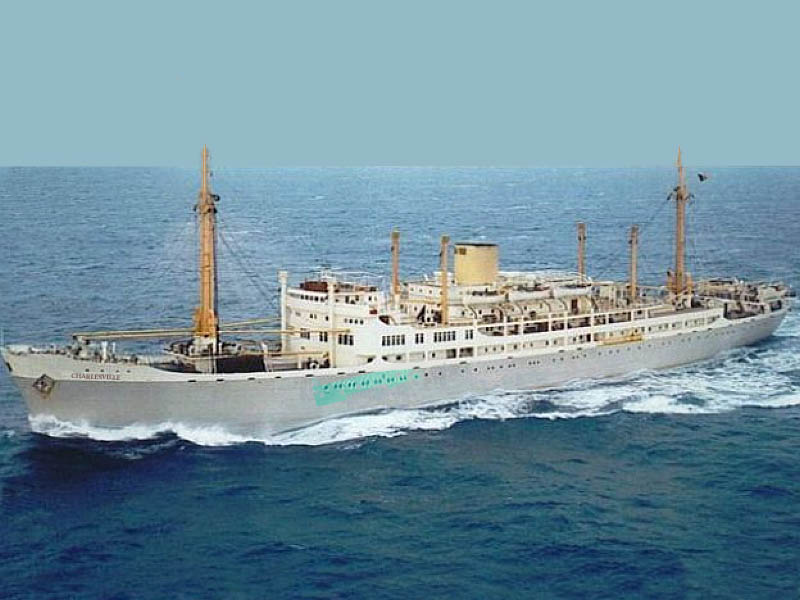
A
fine study of a beautifully designed small passenger-cargo liner
in the late 1940s!
************************
“Blue Water Liners sailing to the
distant shores.
I watched them come, I watched them go, and I watched them
die.”
************************
ENTER
OUR ssMaritime MAIN
INDEX
Where you will discover
over 750 Classic Passenger & Passenger-Cargo Liners!
ssMaritime.com & ssMaritime.net
Where
the ships of the past make history & the 1914 built
MV Doulos Story
Photographs on ssmaritime and associate
pages are by the author or from the author’s private
collection. In addition there are some images that have been
provided by Shipping Companies and private photographers or
collectors. Credit is given to all contributors. However, there
are some photographs provided to me without details regarding the
photographer/owner concerned. I hereby invite if owners of these
images would be so kind to make them-selves known to me (my email
address may only be found on www.ssmaritime.com), in order that due
credit may be given.
This notice covers all pages, although,
and I have done my best to ensure that all photographs are duly
credited and that this notice is displaced on each page, that is,
when a page is updated!
ssMaritime
is owned & © Copyright by Reuben Goossens - All Rights
Reserved




































